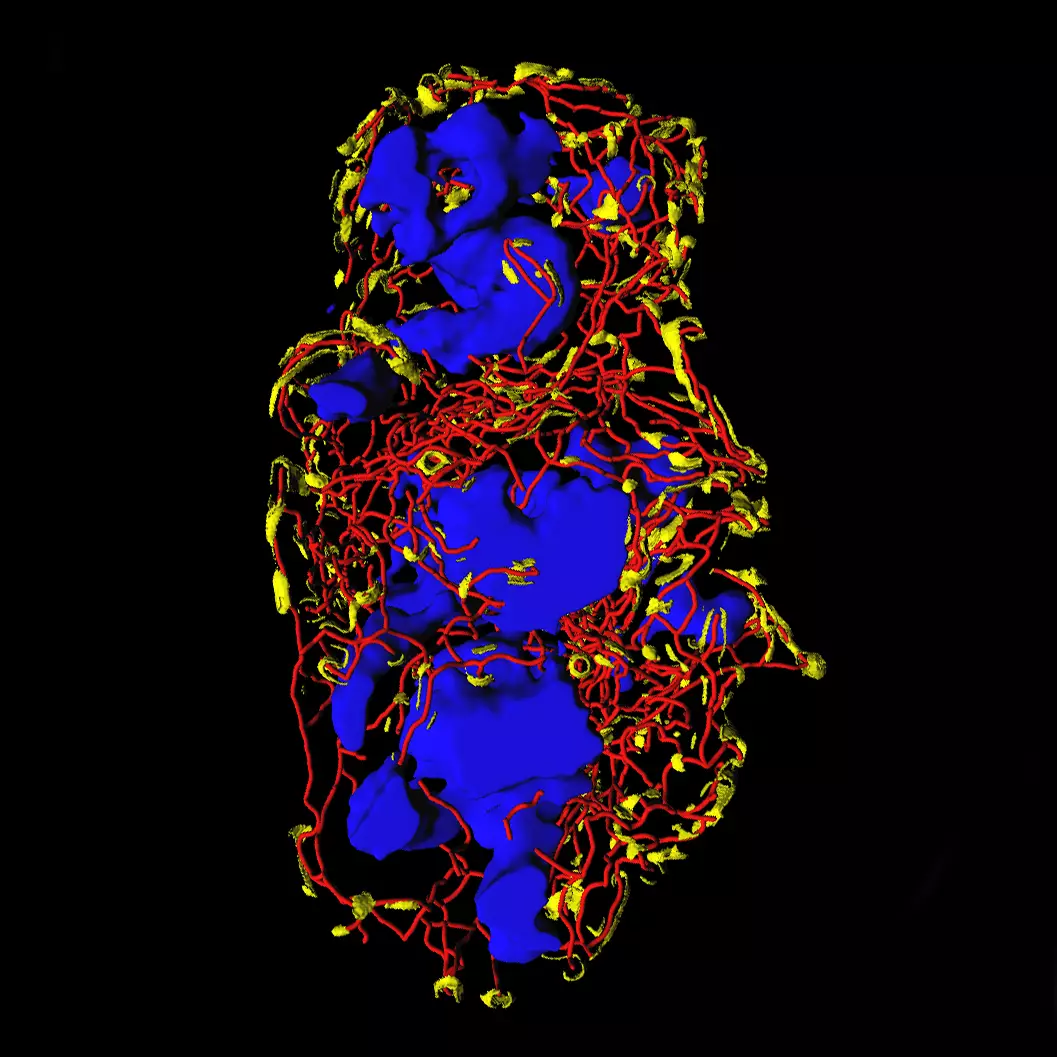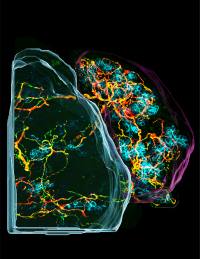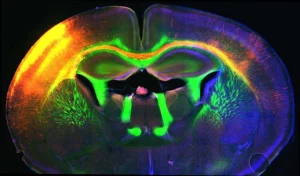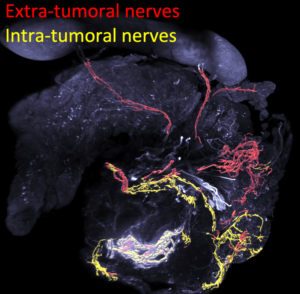Neural plasticity in cancer development
We aim to understand how the nervous system innervates cancerous tumours in order to regulate their development and progression.
The functioning of the nervous system is based on highly sophisticated neural networks that are formed during fetal life and childhood. During development, neurons emit long cables, called axons, to reach their target cells and establish synaptic contacts. This process is controlled by groups of specialized cells that express guidance signals and direct axons along specific trajectories. The nerve projections thus established are maintained throughout adult life. Far from being static, they retain a degree of plasticity that allows them to reshape themselves according to our experiences or in response to diseases such as cancer. Indeed, malignant tumors are able to stimulate the regrowth of mature axons and thus promote their own innervation. The importance of this phenomenon on the evolution of the disease is only beginning to be understood: the nervous system has a protective or, on the contrary, accelerating effect on tumor development, which depends on both the type of cancer and the biochemical properties of the infiltrated axons. These results raise fundamental questions that we seek to answer:
How do axonal projections remodel as a tumor develops?
How does the combination of chemical and mechanical signals generated by the tumor control axonal growth and plasticity?
How do neurons interact with cells in the tumor microenvironment and contribute to disease progression?
Publications
VPS35 deficiency in the embryonic cortex leads to prenatal cell loss and abnormal development of axonal connectivity
Sympathetic axonal sprouting induces changes in macrophage populations and protects against pancreatic cancer
Developmental Upregulation of Ephrin-B1 Silences Sema3C/Neuropilin-1 Signaling during Post-crossing Navigation of Corpus Callosum Axons
Post-endocytic sorting of Plexin-D1 controls signal transduction and development of axonal and vascular circuits
Microtubule-associated protein 6 mediates neuronal connectivity through Semaphorin 3E-dependent signalling for axonal growth
Semaphorin 3E Suppresses Tumor Cell Death Triggered by the Plexin D1 Dependence Receptor in Metastatic Breast Cancers
Transient demyelination causes long-term cognitive impairment, myelin alteration and network synchrony defects
Characterization of a new mouse line triggering transient oligodendrocyte progenitor depletion
Neuronal miR-17-5p contributes to interhemispheric cortical connectivity defects induced by prenatal alcohol exposure.
VPS35 deficiency in the embryonic cortex leads to prenatal cell loss and abnormal development of axonal connectivity
Sympathetic axonal sprouting induces changes in macrophage populations and protects against pancreatic cancer
PlexinD1 and Sema3E determine laminar positioning of heterotopically projecting callosal neurons.
Developmental Upregulation of Ephrin-B1 Silences Sema3C/Neuropilin-1 Signaling during Post-crossing Navigation of Corpus Callosum Axons
Post-endocytic sorting of Plexin-D1 controls signal transduction and development of axonal and vascular circuits
Characterizing Semaphorin Signaling Using Isolated Neurons in Culture
Microtubule-associated protein 6 mediates neuronal connectivity through Semaphorin 3E-dependent signalling for axonal growth
Dysfunctional SEMA3E signaling underlies gonadotropin-releasing hormone neuron deficiency in Kallmann syndrome
Sema3E/PlexinD1 regulates the migration of hem-derived Cajal-Retzius cells in developing cerebral cortex
Semaphorin 3E Suppresses Tumor Cell Death Triggered by the Plexin D1 Dependence Receptor in Metastatic Breast Cancers
Navigation rules for vessels and neurons: cooperative signaling between VEGF and neural guidance cues.
Pathfinding of corticothalamic axons relies on a rendezvous with thalamic projections.
Integration of repulsive guidance cues generates avascular zones that shape mammalian blood vessels.
Semaphorin 3C is not required for the establishment and target specificity of the GABAergic septohippocampal pathway in vitro.
Sema3E-PlexinD1 signaling selectively suppresses disoriented angiogenesis in ischemic retinopathy in mice.
Transient neuronal populations are required to guide callosal axons: a role for semaphorin 3C.
PlexinD1 glycoprotein controls migration of positively selected thymocytes into the medulla.
Gating of Sema3E/PlexinD1 signaling by neuropilin-1 switches axonal repulsion to attraction during brain development.
News
Schwann cells undergo adaptive reprogramming to promote successful neuronal remodeling in pancreatic cancer.
Alcohol and brain development
The Mann team identifies the microRNA-17-5p as responsible for alcohol-related brain connectivity defects.
Several awards for IBDM members !
NeuroStories 2022: Emprise de tête
Mike Altounian presented his work on the effects of alcohol on neural circuit development at Neurostories 2022.
Nervous But Sympathetic !
In this study, the Mann team showed that pancreatic cancer development promotes the sprouting and growth of sympathetic axons.
No jobs opportunities found..































